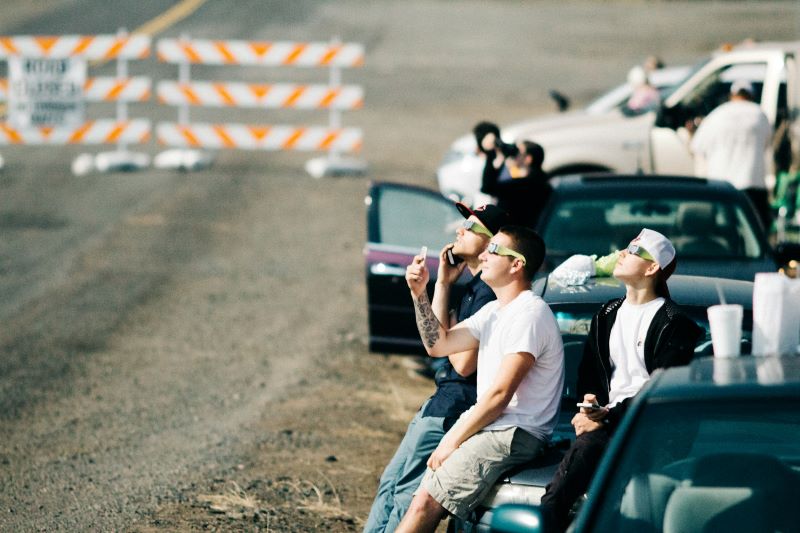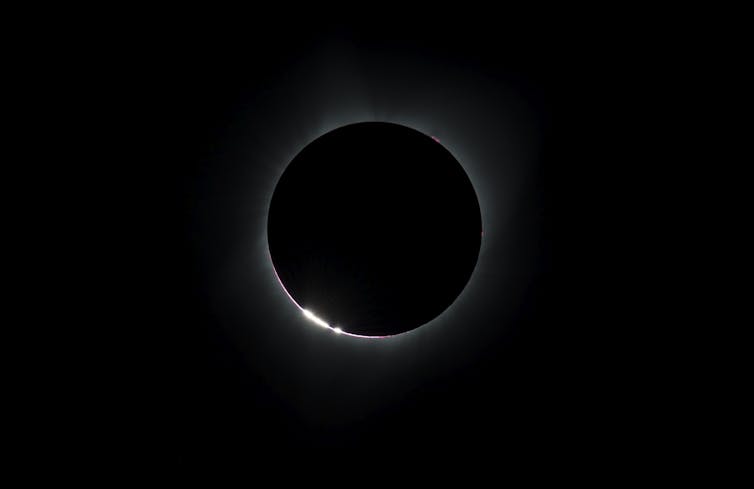
By Nikhil Arora, Queen’s University and Mark Richardson, Queen’s University
Total solar eclipse ties with science, culture and history
On April 8, 2024, there will be a total solar eclipse across North America. This is an opportunity to experience, learn from, and participate in the excitement and wonder. And rather than hiding inside, researchers have been communicating how people can safely enjoy this unique opportunity.
Roughly every 18 months, the sun, moon and Earth come into perfect alignment. And so, somewhere on Earth experiences a solar eclipse. During this phenomenon, the moon casts a roughly 155-mile-wide (250-km-wide) shadow onto Earth.
This ephemeral daytime darkness can be a once-in-a-lifetime experience. On average, any one spot on the globe experiences a total solar eclipse every 375 years.
Our interpretation of, and response to, total solar eclipses has advanced enormously. People once considered eclipses as cosmic omens that predicted dying kings, good harvests or the need for new territorial treaties. Today, they provide a unique opportunity to consider the physical nature of the universe. And we feel a cosmic privilege of witnessing the alignment of the moon and sun.
Total solar eclipse and myth
Due to their sudden darkness, many have perceived solar eclipses through history as catastrophic events. Many societies developed stories to explain these unusual events, often filled with fear and violence.
Indian myths tell of an immortal demon seeking revenge on Vishnu by trying to eat the sun and moon. The Pomo, Indigenous people of Northern California, describe a huge angry bear trying to eat the sun. In other mythologies, eclipses were thought to be heavenly forces removing our source of warmth and life.

Science and total solar eclipses
Beliefs about eclipses motivated ancient Greek astronomers to create the antikythera mechanism, a complex analog computer that predicted the timing of future eclipses with a precision of 30 minutes. These predictions were critical for Greek society. In ancient Greece, a solar eclipse could mean an upcoming death of the king, requiring the appointment of a pseudo-emperor to be killed instead.
Our reactions to eclipses have evolved, driving us to better understand the solar system and the universe at large.
During the eclipse on August 18, 1868, astronomers Norman Lockyer and Pierre Janssen each studied the light from the solar corona to discover a new chemical element. This chemical element was helium, named for the Greek word for the sun.
On May 29, 1919, Frank Watson Dyson and Arthur Stanley Eddington studied the bent path of starlight during a total solar eclipse. It was the first experimental triumph of Einstein’s theory of general relativity.
Total solar eclipse experiences
A total solar eclipse is unlike many other cosmic events, such as meteor showers or comets, which require expensive telescopes or dark sky places. Eclipses are a barrier-free celestial event. You don’t need anything to see a total solar eclipse. And to safely enjoy the partial phases of an eclipse, you simply need eclipse viewing glasses or simple materials to build a viewer.
For example, many universities across Canada are using the opportunity of the total solar eclipse to engage with people to safely experience this astronomical phenomenon. Queen’s University in Kingston, Canada, is making 120,000 eclipse glasses available to make safe eclipse viewing possible for anyone.
In the spirit of education, hundreds of eclipse ambassadors are heading to schools to engage with students about having a profound and safe experience during the eclipse. These ambassadors lead workshops on building inexpensive pinhole cameras to project the sun during the eclipse. They explain unique features that can be seen during eclipses, such as Baily’s beads and the diamond ring effect. And they help everyone appreciate the vastness of the solar system.
These efforts demonstrate the universal value of science, and promote science engagement beyond classrooms and institutions.

Advancing scientific knowledge
The upcoming eclipse is an opportunity to inspire the next generation of scientists. But it’s also an opportunity for the advancement of scientific knowledge. Unlike the experiments of Dyson, Eddington and Lockyer that were limited to the academy, today’s institutions are mobilizing the public to conduct citizen science experiments.
Initiated by NASA, the Eclipse Megamovie project will use photos taken during totality to study the solar corona. In 2017, photos collected during the total eclipse helped researchers identify a plasma plume in the solar corona. The 2024 eclipse will help researchers study this plume in greater detail.
Anyone with a DSLR camera and a tripod can submit a picture of the total solar eclipse to the Eclipse Megamovie project. The public data collected for the 2024 eclipse will far exceed what could be accomplished by any one experiment or location.
A chance to get people excited about science
April’s total solar eclipse, and others to come, will remind people that science is exciting and inspiring, and that scientific expertise is of profound universal value. Such a celestial coincidence is an opportunity to engage with local communities and discuss the origin and mechanics of our solar system, all while including the public in scientific discovery through crowd-sourcing images of their experience.
All that’s left is to hope for clear skies and marvel once more at the cosmos.
Nikhil Arora, Postdoctoral fellow, Physics, Engineering Physics & Astronomy, Queen’s University, Ontario and Mark Richardson, Manager for Education and Public Outreach, Adjunct Professor of Physics and Astronomy, Queen’s University, Ontario
This article is republished from The Conversation under a Creative Commons license. Read the original article.
Bottom line: A total solar eclipse touches on several disciplines of knowledge. Not only science, but also how different cultures have interpreted and dealt with eclipses throughout history. Universities use the April 8, 2024, total solar eclipse to engage with the general public via these topics.
Read more: Total solar eclipse eye protection: How and when?
Read more: Fake eclipse glasses polluting marketplace, astronomers warn
Watch EarthSky’s eclipse countdown here
![]()











